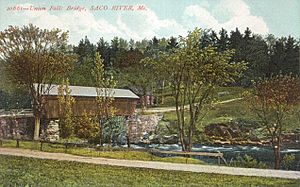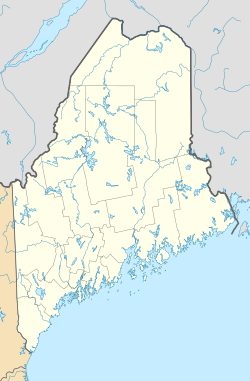Dayton, Maine facts for kids
Quick facts for kids
Dayton, Maine
|
|
|---|---|

Union Falls Bridge, c. 1908
|
|
| Country | United States |
| State | Maine |
| County | York |
| Incorporated | 1854 |
| Government | |
| • Type | Board of Selectmen |
| Area | |
| • Total | 18.40 sq mi (47.66 km2) |
| • Land | 17.89 sq mi (46.33 km2) |
| • Water | 0.51 sq mi (1.32 km2) |
| Elevation | 220 ft (67 m) |
| Population
(2020)
|
|
| • Total | 2,129 |
| • Density | 119/sq mi (46.0/km2) |
| Time zone | UTC-5 (Eastern (EST)) |
| • Summer (DST) | UTC-4 (EDT) |
| ZIP code |
04005
|
| Area code(s) | 207 |
| FIPS code | 23-16725 |
| GNIS feature ID | 0582434 |
| Website | http://www.dayton-me.gov/ |
Dayton is a small town in York County, Maine, United States. It is located close to the cities of Saco and Biddeford. Dayton shares a land border with Biddeford and is next to Saco along the Saco River. It is also part of the larger metropolitan area that includes Portland and South Portland. In 2020, about 2,129 people lived in Dayton. It is one of the smaller towns in York County.
Contents
History of Dayton
Early Inhabitants and Settlement
Long ago, the area where Dayton is now was home to the Sokokis (or Saco) Indians. They hunted and fished along the Saco River. Today, an old trail they used, called the Sokokis Trail, is now Route 5, which goes through Dayton.
In 1664, a man named Major William Phillips bought land from the local sagamore (a Native American leader). This land later became known as Little Falls Plantation. It included what are now the towns of Hollis, Dayton, and part of Limington.
In 1728, a stockaded fort was built near Union Falls. A stockade is a fence made of strong wooden posts. This fort also had a trading post, where people could trade goods. It was called the Saco Truck House or Saco Block House. This fort was used during the French and Indian War until 1759.
Growth and Industry
Settlers started arriving in 1753. Lumbering, which is cutting down trees for wood, became a very important business. Logs were rolled into the Saco River and floated to sawmills in Saco. In 1782, Nathaniel Goodwin built the first local mill at Goodwins Mills. Another sawmill and a gristmill (for grinding grain) were built at Union Falls in 1806. People also built tanneries to make leather, and they cleared land to create farms.
How Dayton Got Its Name
In 1798, Little Falls Plantation was officially named Phillipsburg, to honor Major William Phillips. But people found Phillipsburg hard to say and write. So, in 1810, the name was changed to Hollis.
Later, in 1854, the southern part of Hollis wanted to become its own town. They asked the state government for permission, and it was granted. The new community was named Dayton, after Thomas Day, who was the person who asked for the separation.
Important Events and Changes
In 1860, the people of Dayton decided to build a covered bridge at Union Falls. It was 112 feet (34 meters) long and 18 feet (5.5 meters) wide, connecting Dayton to Buxton. In 1921, this bridge was blown up by the Clark Power Company. This event was even filmed for a movie!
A very sad event happened in 1947, known as the Great Fires of 1947. These fires destroyed two-thirds of Dayton. Many homes, barns, and even the town hall were lost.
In 1951, the Central Maine Power Company built a hydroelectric dam called Skelton Dam. This dam was built between Salmon Falls and Union Falls. It caused a beautiful gorge to be covered by water. A new road, Company Road, was built because the old road was cut off by the dam.
Dayton used to have many dairy farms. Today, it is mostly a place where people live, with fewer farms.
Geography
Dayton covers a total area of about 18.40 square miles (47.66 square kilometers). Most of this area, about 17.89 square miles (46.33 square kilometers), is land. The rest, about 0.51 square miles (1.32 square kilometers), is water. The Saco River flows through and drains the town.
Important roads in Dayton include Route 5 and Route 35, which cross each other here. Other major roads like U.S. Route 202 and Interstate 95 pass just outside the town.
Dayton shares borders with several other towns: Lyman, Hollis, and Buxton. It also borders the cities of Saco and Biddeford.
Population Information
The population of Dayton has changed over the years. Here's a look at how many people have lived in Dayton during different census years:
| Historical population | |||
|---|---|---|---|
| Census | Pop. | %± | |
| 1860 | 701 | — | |
| 1870 | 611 | −12.8% | |
| 1880 | 592 | −3.1% | |
| 1890 | 500 | −15.5% | |
| 1900 | 473 | −5.4% | |
| 1910 | 395 | −16.5% | |
| 1920 | 391 | −1.0% | |
| 1930 | 379 | −3.1% | |
| 1940 | 454 | 19.8% | |
| 1950 | 502 | 10.6% | |
| 1960 | 451 | −10.2% | |
| 1970 | 546 | 21.1% | |
| 1980 | 882 | 61.5% | |
| 1990 | 1,197 | 35.7% | |
| 2000 | 1,805 | 50.8% | |
| 2010 | 1,965 | 8.9% | |
| 2020 | 2,129 | 8.3% | |
| U.S. Decennial Census | |||
As of the census in 2010, there were 1,965 people living in Dayton. Most of the people were White (97.6%). A small number were African American, Native American, or Asian. About 0.8% of the population was Hispanic or Latino.
The average age of people in Dayton in 2010 was about 40.5 years old. About 25.7% of the residents were under 18 years old.
Education
Children in Dayton attend different schools depending on their grade level.
Students in kindergarten through 5th grade go to the Dayton Consolidated School. Since July 1, 2014, this school has been its own school district. It shares a superintendent and other administrative tasks with the Biddeford School System.
Before July 2014, students in grades 6 through 8 went to Saco Middle School. Now, they attend Thornton Academy Middle School.
For high school, students in grades 9 through 12 used to only go to Thornton Academy. But since July 2014, they have a choice between attending Thornton Academy or Biddeford High School.
See also
 In Spanish: Dayton (Maine) para niños
In Spanish: Dayton (Maine) para niños


